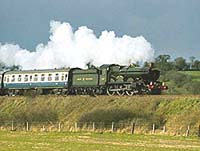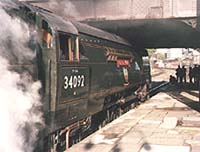| |
7029
CLUN CASTLE: 22nd
May 1982: DORRIDGE-DIDCOT: On the "Salopian" railtour, 7029
ran very respectably with a modest 8 coach load. After the Tyseley stop,
we reached 71 mph before Warwick and made a good climb up to Southam
Road. With an easy schedule, we were 17 mins early into Didcot. [view log of 7029]
19th
June 1982: DIDCOT-DORRIDGE: On another "Salopian" railtour,
7029 had a more substantial 350/375 ton load. A fast run to Oxford was a
prelude to good work thereafter, particularly on Hatton bank.
Excellent. [view log of 7029]
9th
June 1985:
STRATFORD-TYSELEY: Birmingham Railway Museum ran a series of Tyseley to
Stratford "Shakespeare Express" shuttles over the 8th/9th
June, and this was the Sunday 5.05pm from Stratford, the final train of
the weekend. With 9 coaches, 7029 climbed both Wilmcote bank and the
long climb to Earlswood in style. [view log of 7029]
8th
June 1986:
STRATFORD-TYSELEY: The "Shakespeare Express" was repeated in
1986, using two locomotives and a 12 coach train. Again on the final
train of the weekend, the 8.05pm from Stratford, 7029, with it's 439/450
ton train, went splendidly up the 1 in 75 to Wilmcote (29 mph at the
summit), and climbed well to Earlswood. [view log of 7029]
|
|

